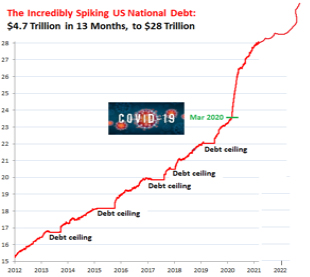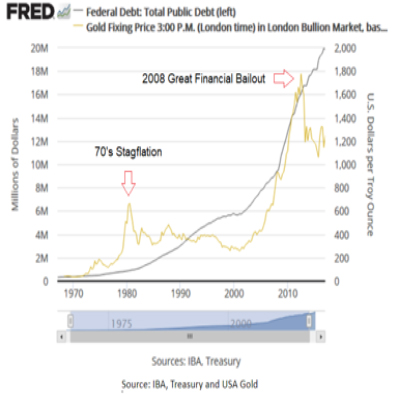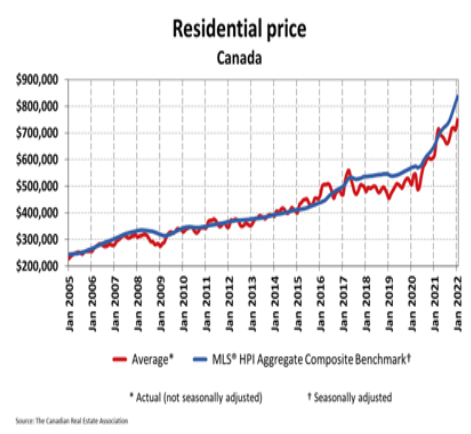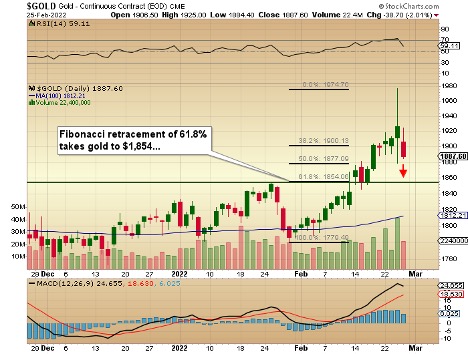Click here to get this article in PDF
Source: Michael Ballanger 02/28/2022
In light of news events of the past week, Michael Ballanger sat in disbelief as gold traded from $1,976.20 to under $1,890 in one single trading session.
This week was arguably the most bizarre in all of my 45 years covering capital markets, and I do not write this lightly.
It was so much so that I really do not know where to begin this week’s missive. I am not going to talk about the geopolitical theater other than to thank Vlad the Impaler for finally moving the Canadian news cycle from COVID counts to something — ANYTHING — else. I am not going to talk about the truckers’ convoy or the local Ottawa gendarme covering up their I.D. badges before engaging the protesters. I am not going to talk about Bank of America dumping a billion ounces of paper silver on Thursday, nor am I going to talk about my favorite hockey player of the last six years — Auston Matthews — leading the league in goals after a three-point performance last night. What I am going to discuss is the topic of “Broken Markets.”
“Here is my ‘bottom line’ assessment of the current state of the gold and silver markets: Since the Great Financial Crisis (bank bailout) of 2008, global central banks have debased every single currency beyond all rational expectation and yet, gold remains at an inflation-adjusted level a mere fraction of the 1979 peak.”
Proof positive of the difficulty of writing this week’s missive is the confluence of “topics of interest.” After watching the market action in the session following this week’s “news event,” I sat in veritable disbelief as gold traded from $1,976.20 to UNDER $1,890 in one single trading session. The quoted price at which a tonne of gold bullion could swing by a factor of 4.61% is a testimonial to the vitriol targeted toward gold’s role as a “safe haven” and to the extent that I have been a stalwart proponent of gold ownership as a method of insulating portfolios from damage brought about by profligate currency debasement, I now stand firmly in the “agnostic” camp, which is exactly where the cryptocurrency disciples carry their swords.
In 1983, the late market technician Ian McAvity, with whom I shared many cocktails over our collective careers, told me that “you don’t want to walk down the street with a gold price at $1,000,” and now that it is at nearly $2,000, I am certain that my dear late friend is turning in his grave.
Here is my “bottom line” assessment of the current state of the gold and silver markets: Since the Great Financial Crisis (bank bailout) of 2008, global central banks have debased every single currency beyond all rational expectation and yet, gold remains at an inflation-adjusted level a mere fraction of the 1979 peak. Central banks have printed more confederate currency in the past two years than in the prior 20. Central bank governors have been trading stocks into overtly biased policy decisions that they KNEW would spur massive buying/trading profits. What happened on the date of the “event” was an “ordered takedown” of all assets that might substantiate the narrative surrounding either “inflation” or “Fed Tightening.” As gold and silver are the chosen canaries, gold and silver were “taken” down. It was not a normal bout of profit-taking or asset re-allocation; it was the Western bullion banks shaping the narrative that not even military action in eastern Europe can cause a panic into gold.
As I sit here looking out over the lovely swamp Scugog, now frozen over and covered with several feet of snow, I sip on a well-earned Cabernet and ponder the wisdom of stubbornly adhering to an ancient, near-forgotten practice of using precious metals as a defense against a) government-sponsored counterfeiting of one’s domestic medium of exchange (currency units), b) confiscation of one’s financial assets (refer to Canada’s “Emergency Measures Act” of 2022), and c) geopolitical turmoil. While citizens of countries such as Poland (1939), Hungary (1946), Yugoslavia (1992), and Zimbabwe (2004-2009), as well as those witnessing the ongoing monetary conflagrations in Venezuela and Turkey, are living through eras where either U.S. dollars or gold are acting in the truer sense of “safe-haven” assets, credit creation in all of those countries combined is a mere rounding error compared to what is ongoing in Washington, London, Brussels, Tokyo, and Ottawa.
If we were all seated in a Cambridge Club Investment Conference in the year 2012, and the speaker pulled up a chart showing us how the national debt of the US, then a tad over $15 trillion (with a “T”), would double to over $30 trillion by the year 2022, we would all have our gold price forecasts ratcheted up to levels not even deemed attainable by Peter Schiff.
 If Nostradamus was in the crowd and predicted a global pandemic that would trigger an avalanche of stock-market-rescue measures numbering in the trillions of dollars, yen, euros, and loonies all conjured up by the global banking elite, we would all run out of the room to our local silver bar distributor and empty any and all accounts denominated in fiat with copious amounts of silver bars, coins, wafers, and trinkets in a desperate mission to avoid the total destruction of purchasing power.
If Nostradamus was in the crowd and predicted a global pandemic that would trigger an avalanche of stock-market-rescue measures numbering in the trillions of dollars, yen, euros, and loonies all conjured up by the global banking elite, we would all run out of the room to our local silver bar distributor and empty any and all accounts denominated in fiat with copious amounts of silver bars, coins, wafers, and trinkets in a desperate mission to avoid the total destruction of purchasing power.
 This graph is a tip-off to the point in history where five thousand years of historical utility for gold and silver as debasement hedges (as opposed to inflation hedges) and it all reverts back to 2009. The Great Financial Bailout of 2008-2009 had immense implications not on the actual consumer price index but rather the rising level of inflationary expectations. That has always been the Fed’s mortal enemy because when people expect to see food and energy and rent embark upon an upward price spiral, their purchasing behavior changes. As we know from watching consumers in India, they empty their checking accounts in favor of gold faster than Justin Trudeau could cancel the Emergency Measures Act (once the polling numbers turned blatantly hostile). Bankers hate this because it reduces the size of deposits against which they can make loans, the life blood of earning flow. Reduce the deposits and it reduces the earnings.
This graph is a tip-off to the point in history where five thousand years of historical utility for gold and silver as debasement hedges (as opposed to inflation hedges) and it all reverts back to 2009. The Great Financial Bailout of 2008-2009 had immense implications not on the actual consumer price index but rather the rising level of inflationary expectations. That has always been the Fed’s mortal enemy because when people expect to see food and energy and rent embark upon an upward price spiral, their purchasing behavior changes. As we know from watching consumers in India, they empty their checking accounts in favor of gold faster than Justin Trudeau could cancel the Emergency Measures Act (once the polling numbers turned blatantly hostile). Bankers hate this because it reduces the size of deposits against which they can make loans, the life blood of earning flow. Reduce the deposits and it reduces the earnings.
 If we were all listening to a Tony Robbins motivational speech sponsored by the Canadian Association of Realtors in 2005 and he told you that the average price of a home (not West Vancouver or Toronto Rosedale or Westmount Montreal) then about CA$230,000 would by 2022 be knocking on the CA$1 million mark, it would not be a “stretch” to assume that the cost of extracting an ounce of gold or silver from the ground would have the same kind of percentage increase as housing. You might then assume that gold and silver producers would push the added costs into their pricing models such that the inability to recover cost increases would result in curtailment of operations. This would inevitably curtail supply and prices would once again correct to the upside.
If we were all listening to a Tony Robbins motivational speech sponsored by the Canadian Association of Realtors in 2005 and he told you that the average price of a home (not West Vancouver or Toronto Rosedale or Westmount Montreal) then about CA$230,000 would by 2022 be knocking on the CA$1 million mark, it would not be a “stretch” to assume that the cost of extracting an ounce of gold or silver from the ground would have the same kind of percentage increase as housing. You might then assume that gold and silver producers would push the added costs into their pricing models such that the inability to recover cost increases would result in curtailment of operations. This would inevitably curtail supply and prices would once again correct to the upside.
Alas, after all of the conferences and motivational speeches and analytical think tank sessions, our collective optimistic assumptions would have to be shunted into a remote realm of one’s data storage facility because relative to what everything else has done since the turn of the century, gold and silver have been relegated to the status of “antiquated” by the million upon millions of young people who have found enlightenment and chosen to reject the notion drummed into them by the “dumb boomers” that gold and silver will be the answer to all of their ailments, concerns, and woes.
Thursday’s action in the precious metals pits was about as ugly as I can recall in my 45-year career following and trading precious metals and the companies that explore for, develop, and produce them. The outbreak of war has always been seen as disruptive to global supply chains and is never a bearish event for gold or silver. I would be less outraged if prices had advanced to new all-time highs in anticipation of the outbreak or responded in a fashion somewhat akin to recent moves in copper and nickel and uranium prices. I fully expected that we would see a “sell the event” reaction to any geopolitically-triggered price spike in either gold or oil but did I expect for one nanosecond that gold would give up all its gains and go out down on the session after a Russian invasion of a sovereign country? I most certainly did not.

As for my expectations for the upcoming weeks, the world’s news cycle has now reverted to the Ukraine so traders will be hanging off every skirmish and sound byte emanating from eastern Europe. Crystal ball analysis is difficult when there is no crystal ball in one’s possession, which means that making trading calls can be hazardous because at the drop of a hat, escalation can send traders running for the exits while cessation of hostilities does the reverse. Absent any surprises, I see gold testing the 61.8% retracement level using the $1,780 low from early January and Thursday’s intraday top at $1,976.20 — which means that my “line in the sand” is now $1,854. A two-day close under that level will force me to reassess the 2022 outlook. The two main drivers are now geopolitical developments and Fed policy changes. On the latter front, a few of the Fed governors are citing the supply shock risks as being a “possible” reason to “modify” the plans to hike rates in March but I would view that as a huge credibility hit to their already staggered persona as an “apolitical entity,” which is utter rubbish.
Looking out over that frozen swamp, the vision of two Millennial snowmobilers screaming northward at 80 mph, engines emitting that ear-splitting whine so familiar to anyone that has lived at or near the Ontario lakes in February brings to mind the ferocity with which they scrambled to “buy the dip” on Thursday leading to a 2.24% rebound in the S&P on Friday. Bear market rallies are to traders what pressure cracks represent to snowmobilers because anyone that has caught a pressure crack ridge at 80 mph gets a sudden margin call of a very different nature. Broken markets and broken snowmobiles both contribute greatly to the meaning of “delayed dreams.”
Originally published Feb. 25, 2022.
Follow Michael Ballanger on Twitter @MiningJunkie. He is the Editor and Publisher of The GGM Advisory Service and can be contacted at miningjunkie216@outlook.com for subscription information.
Originally trained during the inflationary 1970s, Michael Ballanger is a graduate of Saint Louis University where he earned a Bachelor of Science in finance and a Bachelor of Art in marketing before completing post-graduate work at the Wharton School of Finance. With more than 30 years of experience as a junior mining and exploration specialist, as well as a solid background in corporate finance, Ballanger’s adherence to the concept of “Hard Assets” allows him to focus the practice on selecting opportunities in the global resource sector with emphasis on the precious metals exploration and development sector. Ballanger takes great pleasure in visiting mineral properties around the globe in the never-ending hunt for early-stage opportunities.
Sign up for our FREE newsletter at: www.streetwisereports.com/get-news
Disclosure:
1) Statements and opinions expressed are the opinions of Michael Ballanger and not of Streetwise Reports or its officers. Michael Ballanger is wholly responsible for the validity of the statements. Streetwise Reports was not involved in any aspect of the article preparation. Michael Ballanger was not paid by Streetwise Reports LLC for this article. Streetwise Reports was not paid by the author to publish or syndicate this article.
2) This article does not constitute investment advice. Each reader is encouraged to consult with his or her individual financial professional and any action a reader takes as a result of information presented here is his or her own responsibility. By opening this page, each reader accepts and agrees to Streetwise Reports’ terms of use and full legal disclaimer. This article is not a solicitation for investment. Streetwise Reports does not render general or specific investment advice and the information on Streetwise Reports should not be considered a recommendation to buy or sell any security. Streetwise Reports does not endorse or recommend the business, products, services or securities of any company mentioned on Streetwise Reports.
3) From time to time, Streetwise Reports LLC and its directors, officers, employees or members of their families, as well as persons interviewed for articles and interviews on the site, may have a long or short position in securities mentioned. Directors, officers, employees or members of their immediate families are prohibited from making purchases and/or sales of those securities in the open market or otherwise from the time of the decision to publish an article until three business days after the publication of the article. The foregoing prohibition does not apply to articles that in substance only restate previously published company releases.
Michael Ballanger Disclaimer:
This letter makes no guarantee or warranty on the accuracy or completeness of the data provided. Nothing contained herein is intended or shall be deemed to be investment advice, implied or otherwise. This letter represents my views and replicates trades that I am making but nothing more than that. Always consult your registered advisor to assist you with your investments. I accept no liability for any loss arising from the use of the data contained on this letter. Options and junior mining stocks contain a high level of risk that may result in the loss of part or all invested capital and therefore are suitable for experienced and professional investors and traders only. One should be familiar with the risks involved in junior mining and options trading and we recommend consulting a financial adviser if you feel you do not understand the risks involved.
